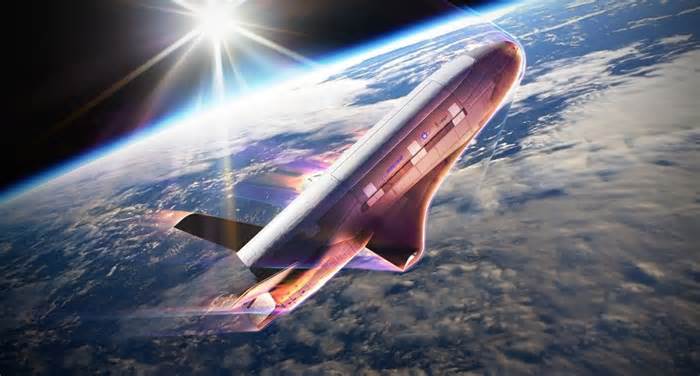
The Secretive Spaceplane of the U.S. Space Force Conducts First-of-Its-Kind Maneuvers
- by Smithsonian Magazine
- Nov 13, 2024
- 0 Comments
- 0 Likes Flag 0 Of 5

November 13, 2024 4:58 p.m.
An artist's rendering of the X-37B conducting an aerobraking maneuver using the drag of Earth's atmosphere, with the bottom of the craft glowing red as it heats up.
Boeing Space
Recently, the United States Space Force surprised space travel enthusiasts and professionals alike by revealing details about its mysterious spaceplaneâs seventh mission. In a statement released on October 10, the agency announced that its Boeing-made X-37B Orbital Test Vehicle would conduct a series of unprecedented aerobraking maneuvers to change its orbital path around Earth. This month, Boeing Space said on social media that the procedure had begun.
âThis first-of-a kind maneuver from the X-37B is an incredibly important milestone for the United States Space Force as we seek to expand our aptitude and ability to perform in this challenging domain,â B. Chance Saltzman, chief of space operations of the U.S. Space Force, said in the statement.
The news is a rare offering of information from the Space Force and Boeing, which are incredibly secretive about the X-37Bâs activities. The craft launched on its first mission in 2010, but few details have been revealed about its highly classified purpose in space.
The newly described aerobraking maneuver allows the X-37B spaceplane to change its orbit by using the Earthâs atmospheric dragâthe friction caused by molecules in the atmosphere. Normally, spacecrafts have to fire their thrusters to achieve a shift in orbit, which uses up propellant and thus can only be done a limited number of times, per Space.comâs Brett Tingley.
âWhen we aerobrake, we utilize atmospheric drag to effectively step down our apogeeââthe farthest point from Earth in the orbitââone pass at a time, until we get to the orbital regime that we want to be in,â John Ealy, a Boeing engineer, says in a video released by the company. âWhen we do this, we save enormous amounts of propellant, and thatâs really why aerobraking is important.â
Because of the way it conserves fuel, aerobraking could allow missions to last significantly longer, per Newsweekâs Tom Howarth.
What is Aerobraking? | X-37B Mid-Mission Demonstration
Watch on
X-37B will change its orbit (or perhaps it already has) in order to dispose of service module components, dropping them off to burn up in the Earthâs atmosphere.
Besides this novel maneuver, the public knows very little about X-37B. It is an unmanned, remotely controlled spaceplane Boeing developed for the U.S. Department of Defense. More broadly, spaceplanes are hybrids between airplanes and spacecraft that can orbit the planet like satellites but also land back on Earth like passenger planes, per Gizmodoâs Passant Rabie. In essence, this ability makes them reusable.
X-37B was launched into space via SpaceXâs Falcon Heavy rocket for its seventh mission (OTV-7) in December 2023. Since then, it has been orbiting Earth in an extremely elliptical path with a perigee (the closest point of an orbit) of 620 miles and an apogee of more than 22,210 miles, per Live Scienceâs Rory Bathgateâthough it has been spotted as close as 185 miles above Earth.
But exactly what itâs doing on that orbit is unclear. âSince December 28, 2023, the United States Space Force, supported by the Air Force Rapid Capabilities Office, has conducted radiation effect experiments and has been testing Space Domain Awareness technologies in a Highly Elliptical Orbit,â is all the agency said of the spaceplaneâs overall mission in the recent statement.
The X-37B Orbital Test Vehicle when it concluded its sixth successful mission.
U.S. Space Force / Staff Sgt. Adam Shanks, Public domain
We do know, however, that past missions have served to study the effect of long-duration space exposure, including space radiation, on seeds.
âSpace is a vast and unforgiving environment where testing technologies is critical to the success of future endeavors,â Michelle Parker, vice president of Boeingâs Space Mission Systems, said in another statement last month. âThere is no other space platform as capable, flexible and maneuverable as the X-37B, and its next demonstration will be another proof point that this test vehicle sets the pace of innovation.â
Air Force Secretary Frank Kendall said in a statement that the craft is conducting ânational security missions in space.â Some suspect this to include military surveillance. Many are thus wondering what might have prompted the agency to release information about the X-37Bâs latest maneuver.
âDisclosing this aerobraking maneuver could be the Space Forceâs way of showing the world what the spaceplane is capable of,â Vivienne Machi writes for Aviation Week, âwith an intended audience of anyone from allies and partners, adversaries, lawmakers, industry, potential recruits, and perhaps even the service itself.â
Machi adds that two other reasons for the revelation could include loosening up some of the agencyâs historic and perhaps unnecessary security classification barriers, and/or wanting to prompt China and Russia to also step up communication about space maneuvers.
Once the aerobraking has been completedâand perhaps it already hasâthe spaceplane will return to its secretive objectives.
Get the latest stories in your inbox every weekday.
Margherita Bassi
Please first to comment
Related Post
Stay Connected
Tweets by elonmuskTo get the latest tweets please make sure you are logged in on X on this browser.
Sponsored
Popular Post
Tesla: Buy This Dip, Energy Growth And Margin Recovery Are Vastly Underappreciated
28 ViewsJul 29 ,2024






 Energy
Energy



















